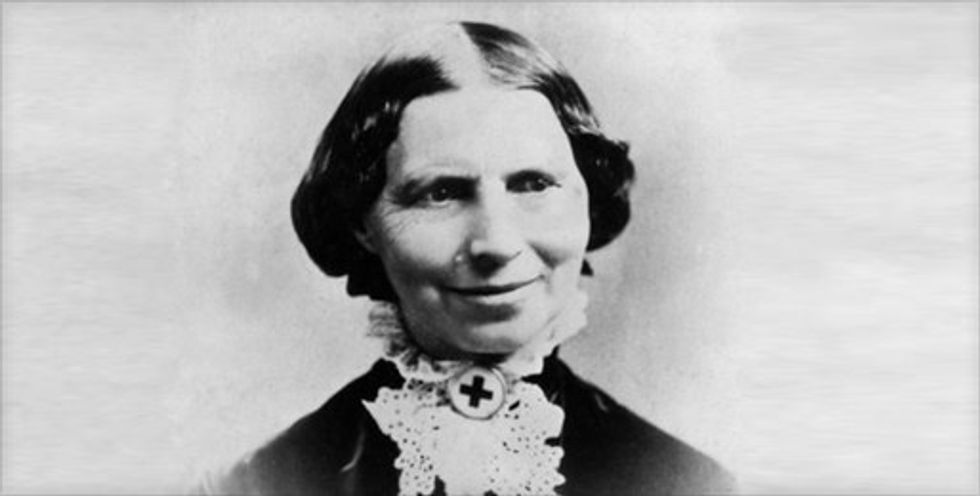Hillary Rodham Clinton just made history as the first woman to receive a nomination for a major party. Because of this historical moment, I wanted to write an article spreading awareness about other accomplished women in history to remind America that women have made progress throughout history. Additionally, I wanted to show that overcoming obstacles is not just a myth seen in movies and books, but in real life as well. Lately when I have been feeling anxious or scared that I won’t achieve my goals, I think of these persevering historical women. There is a saying “you didn’t come this far to get this far,” and with these women, little steps brought them to even bigger steps. More importantly, these women did not let rejection or obstacles stop them from striving to achieve their goals.
- Harriet Tubman: Not only can this female abolitionist be called the “black Moses,” but also the “female Moses.” With her courage, she freed many slaves with the Underground Railroad. As the “conductor” of the Underground Railroad, she set up a base for her family and other fugitives in Canada. She feed, prayed with, and worked for her brothers. Her brothers ended up becoming successful farmers. At. St. Catharines, she formed connections with missionaries who helped with fugitive relief. Later on, the Fugitive Aid Society of St. Catharines was developed, and they accepted donations of clothing and money to provide for the fugitives. Harriet Tubman and her brother, William H. Stewart, acted as committee members. During the civil war, Harriet Tubman was a spy and a nurse. Tubman was also involved in American society even after the Civil War and abolitionism. During the Reconstruction period, Tubman took a strong part in the church community. She was a congregational member of A.M.E. Zion. She made many speeches for the National Women’s Suffrage Organization (NWSO) and the National Association of Colored Women (NACW). Finally, in her later years after along financial struggle, Harriet Tubman achieved her dream of establishing Tubman Home for the Aged. I am so glad that they put her face on the 20 dollar bill. She truly deserves it
2. Helen Keller: She was the first deafblind person to receive a college degree. When she was a student at Radcliffe College, she learned many languages including Greek, German, French, and Latin. She wrote books about how she faced and overcame her obstacles including “Story of My Life,” “The World I Live In,” and “Light in My Darkness.” She spread and continues to spread the message that being disabled doesn't mean you cannot achieve your dreams nor become an influential leader. Helen Keller became an ambassador for the American Foundation for the Blind. In addition, she joined the American Civil Liberties Union (ACLU) and made many speeches. She even communicated with senators and other politicians. Credit should also go to her teacher Anne Sullivan. Without Anne Sullivan's patience and dedication, Helen Keller would not have been so accomplished.
3. Eleanor Roosevelt: Eleanor goes down in history as one of, if not the most, powerful first lady in the history of U.S. Presidency. After all, she was the first wife of a president to ever make a speech at As first lady to FDR, Eleanor held press conferences for women who wanted to become journalists. Consequently, many women got positions in the journalism field. Eleanor had an interest in writing herself. She had newspaper columns called “Mrs. Roosevelt’s Page” and “My Day.” In addition, she wrote articles for magazines including Harvard Law Review, Atlantic Monthly, and New Republic. Her article topics included foreign relations and policy, peace, civil rights, women’s issues, and labor. Eleanor Roosevelt not only wrote about politics, but also the importance of reading. “For many years she served on the editorial board of the Junior Literary Guild-a book club for young readers,” according to Candace Fleming. “In her magazine articles she advocated reading aloud to children and believed even babies and toddlers should be immersed in the world of literature.” She acted upon this belief by working to set up libraries across the United States. Eleanor Roosevelt said, “we must insist on libraries for every community...for what we get, in the end, is stimulation of intellectual thought, individual curiosity and the chance to make a democracy that will be a real democracy.” Eleanor even wrote fiction books herself. One book was called A Trip to Washington with Bobby and Betty, and the other was called Christmas: A Story. Eleanor’s involvement with press and journalism was not limited to books and magazines. As a matter of fact, she spoke her political views on public radio, particularly her views on women’s rights. Eleanor did not just help women, but African Americans as well. When African-American opera singer Marian Anderson was prevented from singing at Constitution Hall, Eleanor stepped down from the Daughters of the American Revolution (DAR) and helped her perform at the Lincoln Memorial. As a result of Eleanor’s persuasion, radio stations did a live broadcasting of Marian’s performance. Marian’s performance acted as a fundraiser for the NAACP. Eleanor Roosevelt’s altruism was also seen during World War Two when she persuaded congress to assist refugees with safely entering the United States. Many Americans said that she should become president herself. Even after her husband left office, Eleanor was still involved in politics as a delegate for the United Nations.
4. Rosa Parks: She was very brave to face the risk of refusing to move out of her seat. Her resulting arrest created a very strong ripple effect. This led to the NAACP forming the Montgomery bus boycott. When Rosa Parks went on trial, several African American civil rights leaders including Martin Luther King Jr. established the Montgomery Improvement Association, and they vowed to continue boycotting until action was taken to end segregation. During the boycott, Rosa Parks was asked to make speeches about her her experience on the bus. “I was invited to tell about what happened to me at various churches, schools, and organizations,” according to Parks; “I represented the Montgomery NAACP and met the national officers a few times.” Boycotts continued to the point where Martin Luther King Jr. and Rosa Parks got arrested. The controversial case of Rosa Parks went to the Supreme Court, and the Supreme Court ruled that segregation in public locations was illegal. 9 years afterwards, Lyndon B. Johnson passed the Civil Rights Act of 1964, which ended segregation completely and deemed prejudice against race, ethnicity, and gender as illegal. Similar to how Harriet Tubman was involved in American politics after the Civil War and abolitionism, Rosa Parks did the same after the Civil Rights Act was passed. She helped with the establishment of the Rosa and Raymond Parks Institute for Self Development and the Rosa L. Parks Scholarship Foundation. Overall, Rosa Parks inspired and continues to inspire people to courageously stand up for themselves. Rosa Parks was involved with civil rights before her arrest. In fact, she discusses her time as a secretary for the NAACP in her autobiography “My Story.”
5. Clara Barton: She was the founder of the American Red Cross, an organization that continues to aid those in need today. Clara Barton is a great role model for people who want to show care for others in the fields of nursing, social work, and psychology. She was a Civil War nurse who helped soldiers who were wounded in battle. She did not just provide physical assistance, but also emotional support. In fact, she often read and prayed with the wounded men. A surgeon taking part in the Battle of Cedar Mountain stated, “I thought that night if heaven ever sent out a(n) angel, she must be one-her assistance was so timely.” Consequently, she was called the “Angel of the Battlefield.” Her experience as a committed nurse opened her up to bigger opportunities. In 1869, four years after the American Civil War, Barton travelled to Geneva, Switzerland where she read Henry Durant’s book, “A Memory of Solferino.” This book inspired her to take part in the International Red Cross where she along with other volunteers helped the victims of the 1870 Franco-Prussian War outbreak. She provided clothing and other relief supplies to the French victims. After the city of Strasbourg was conquered, Barton set up workrooms to design new clothing for the citizens. When Clara Barton returned to the United States, she fought for to ratify the Red Cross Treaty. Barton did not let rejection bring her down. President Rutherford B. Hayes disagreed with the treaty and rejected it in 1877, but the treaty was approved in 1882 by Charles Arthur. Clara Barton leaded the American Red Cross with helping victims of natural disasters for 20 years until she resigned.
http://www.redcross.org/about-us/history/clara-barton
6. Temple Grandin: Similar to Helen Keller, Temple Grandin is a woman who does not let her disability define who she is. Not only is Grandin a great role model for autism and disability rights advocates, but for animal rights advocates as well. Temple Grandin always felt that she understood the emotions of animals. After all, she is a professor of animal science at Colorado State University. She always believed that like animals, she “thought in pictures” rather than verbally, and this brought her to do studies on how animals can help us understand humans. This inspired her to write her book “Animals in Translation.” “She is the only person in the world has been honored by People for the Ethical Treatment of Animals as a visionary and has been inducted into the Meat Industry Hall of Fame,” according to Sy Montgomery. During her younger years, she loved carpentry and art. She particularly had a passion for drawing horses. Temple also loved reading about inventors in history. These skills and interests continued During summer vacation one year, Temple Grandin placed herself in a cattle chute to calm herself down when having panic attacks. This prompted her to design a “squeeze machine” to experiment on animals and humans. With this motivation to invent such a machine, she studied hard in science and ended up graduating second in her class. During her college years from bachelors to masters to PhD., Temple worked hard to improve and enhance her invention that would alleviate animal suffering. Similar to how Clara Barton did not let Rutherford B. Hayes’ rejection stop her from establishing the American Red Cross, Temple did not let one professor’s negative opinion about the squeeze machine stop her from experimenting on it. Temple’s “hugging machine” opened her up to new opportunities in livestock technology design and construction. She designed a safe new dip vat that would impress ranchers from other countries. Additionally, she designed alleys for cattle to move together so they do not feel apart. Overall, Temple Grandin’s accomplishments are not just revelations in farm technology, but also psychology and animal science.
Book Resources:
Harriet Tubman: The Life and the Life Stories by Jean M. Humez
Our Eleanor by Candace Fleming
Temple Grandin: How the Girl Who Loved Cows Embraced Autism and Changed the World by Sy Montgomery
My Story by Rosa Parks






















